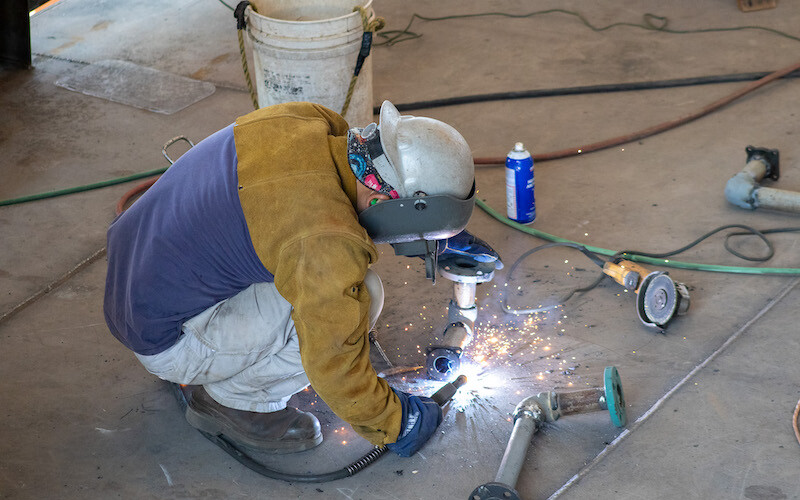From Mississippi to Florida, recruiting and retaining shipyard workers remains an uphill battle. Though the pool of shipyard workers is deep along the Gulf Coast, big yards like Ingalls Shipbuilding, Pascagoula, Miss., and Austal USA, Mobile, Ala., that employ thousands of workers drain the pool of experienced craftsmen and craftswomen for smaller yards.
"We recently had a week where we brought in 45 to 50 people," said Garrett Rice, Master Boat Builders, Coden, Ala. "I think we kept seven."
Master Boat has plenty of work. Among the boats in the yard and in the water are two 86'x36' escort tugs for Moran Towing Corp., which will be followed by two more Moran tugs — two 92'x40' escort tugs, and the much publicized Crowley 82'x40' e-Wolf, a tug which will be the first fully electric ship-assist tug in the U.S. and is designed to be the first zero-emission tugboat. Small gensets will be available if needed, but the tug is expected to operate primarily on batteries that are recharged at night at a dock in San Diego, where it will operate. "We have six different designs in the yard right now," said Rice.
In Pascagoula, Miss., Signet Shipbuilding & Repair just delivered the first of two 103'4"x45'6"x15'7" Robert Allan-designed Rotortugs to its parent company, Signet Maritime. Signet Sirius will be followed by its sistership Signet Capella later this year. Both will work in the Corpus Christi Ship Channel in Texas.
For Signet, safety is the linchpin to attracting and keeping shipyard workers.
"If you have a safe working environment, it will lead to a more productive environment," said Gayle C. Snyder, Signet's executive vice president, administration, infrastructure & special services. "We have an incident rate of 0.48 as a four year average. We're pretty proud of that."
Signet has plans for expansion which means a greater need for shipyard workers. "Besides the hourly wage, we have all the incentives," said Hans L. Schmidt, the yard's president. "The 401 k, the food allowance. But it's been a challenge."
Eastern Shipbuilding Group, Panama City, Fla., is working on a number of contracts including a recently signed deal to build a 320'x72'x28' hopper dredge for the U.S. Army Corps of Engineers. a 302' vehicle/passenger vessel for Bridgeport & Port Jefferson Steamboat, a conversion of a Hornbeck Offshore Gulf of Mexico OSV to an offshore wind service operation vessel, and the contract that is keeping most of the yard's 1,500 shipyard workers busy — four 360'x54' offshore patrol cutters. The OPCs include a draft of 17', speed in excess of 22 knots, a range of 10,200 nautical miles (at 14 knots), endurance for 60-day patrol cycles, capable of carrying an MH-60R or MH-65 helicopter, and three over-the-horizon (OTH) cutter boats. The OPC will conduct missions including law enforcement, drug and migrant interdiction search and rescue, and other homeland security and defense operations. Each OPC will feature a flight deck and advanced command, control, communications, computers, intelligence, surveillance, and reconnaissance equipment.
"We're the biggest manufacturer in the area," said Joey D'Isernia. "But we don't just recruit in the area, we recruit nationwide."
D'Isernia said training and keeping workers at his shipyard, and even in the industry as a whole, is a big challenge. "It's the biggest challenge to shipbuilding in America," he said. "Our craftsmen and women are aging out, and we're not doing a good enough job as a country to educate our young people in the value of the crafts industry. When's the last time you heard of a high school with a shop class?"
D-Isernia said his shipyard works closely with high schools, technical schools, and even elementary schools to make students aware of what leaning a craft like welding and pipe fitting can mean for their careers. "We work very closely with these schools, even help with the curriculum. We've been very successful in doing so."
Steiner Shipyard, Bayou La Batre, Ala., is working on a contract for four 76'x35' 2,000-hp conventional towboats for Florida Marine Transporters, Mandeville, La.
"We been building for Florida Marine for several years now. We get along well," said Tara Steiner Marshall, the yard's owner. "They're in the yard all the time. It's a good relationship."
The shipyard is also working on a 104'x28', 1,200-passenger/vehicle ferry for the Maine Department of Transportation. "Right now we have about 40 to 50 of our workers in the yard," said Marshall. "We've been pretty good at keeping people, but finding new workers that want to work can sometimes be a problem."



.jpg.small.400x400.jpg)

